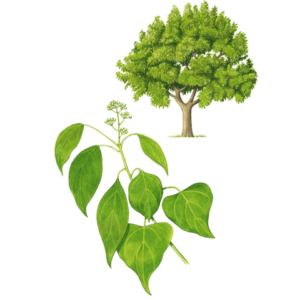
Find out more about the Ravintsara plant of our Aromatherapy Herbarium blog series.

RAVINTSARA
Cinnamomum camphora
Cineolifera
DESCRIPTION

Ravintsara (Cinnamomum camphora) is a medium-sized tree from the Lauraceae family.
ADVICE
This essential oil is remarkably well-tolerated by the whole family; it is non-irritant for the skin and completely non-toxic.
Warning! Drug interactions may occur if the essential oil is used for more than a few days.
DO NOT USE IN
– pregnant or breast-feeding women,
– children under the age of three years,
– persons allergic to one of the components (geraniol, linalool, limonene),
– subjects with asthma without the advice of an allergologist before the first use,
– subjects with epilepsy (or children who have had fever seizures).
RECIPES
Antiviral agent
1 drop of EO of niaouli, 1 drop of EO of palmarosa, 1 drop of EO of ravintsara.
Take the 3 drops on a neutral tablet three times daily for four days.
Physical and psychological fatigue – immune stimulation
Pour 3 drops of essential oil of ravintsara onto the solar plexus, wrists and inner elbow three times per day for ten days.
Herpes labialis (cold sores)
Place 1 drop of pure essential oil of ravintsara onto the cold sore six to seven times per day until healed.
Respiratory problems (children over the age of six years)
Massage your child’s chest three times per days with 5 drops of essential oil of ravintsara diluted in 5 drops of carrier oil.

It has reddish bark and its helically arranged, glabrous and coriaceous leaves are the same as those of the bay laurel (Laurus nobilis). Native to Japan and Taiwan, it was introduced into Madagascar, where grew a related species, but with different properties (Ravensara aromatica).
Madagascar, island of perfumes, is a hub of world phytotherapy as more than six thousand of the island’s plants are studied and some are used by ethnopractitioners according to the database of the Madagascan institute of applied research (IMRA). This prodigious biodiversity was revealed to Europeans during the mid-18th century by the Frenchman Etienne de Flacourt “resident governor” in his History of the island Madagascar (1658). During the 20th century, the botanist Pierre Boiteau scientifically explored this wealth and studied the therapeutic effect of ravintsara. This tree has always been, and remains to this day, the ultimate “medicine tree” of Madagascan populations, its local name meaning “leaves good for everything”. The essential oil extracted from these leaves is remarkable for combating viral diseases.
CULTIVATION AND PRODUCTION
Following a shortage period, Ravintsara production now exceeds worldwide demand. The main importers are France, the United States and Great Britain.
FRAGRANCE
The fresh odour of ravintsara is reminiscent of that of eucalyptus.
EXTRACTION AND YIELD
Steam distillation of the leaves gives essential oil of ravintsara, with a yield of 1 to 2%, i.e. one to two kilograms from one hundred kilograms of plant.
CHEMICAL FORMULA
The main active constituents of essential oil of Cinnamomum camphora are terpene oxides (1,8-cineol), terpene alcohols (alpha-terpineol) and terpenes (pinenes). Camphor is present only in very small amounts and frequently even absent from the chemical variety cineolifera, contrary to the Japanese variety, that has a high camphor content.
MAIN INDICATIONS
Essential oil of ravintsara is an immune stimulant and a potent antiviral and anti-infectious agent. Thanks to its very broad spectrum of action, it is recommended for preventing and treating all forms of viral infection, particularly respiratory – cold, flu, chills, pharyngitis, laryngitis, bronchitis, rhinopharyngitis – along with seasonal gastroenteritis (always viral), herpes and herpes zoster. It is also a tonic, helping relieve states of extreme fatigue and accelerating convalescence.


Leave a Comment